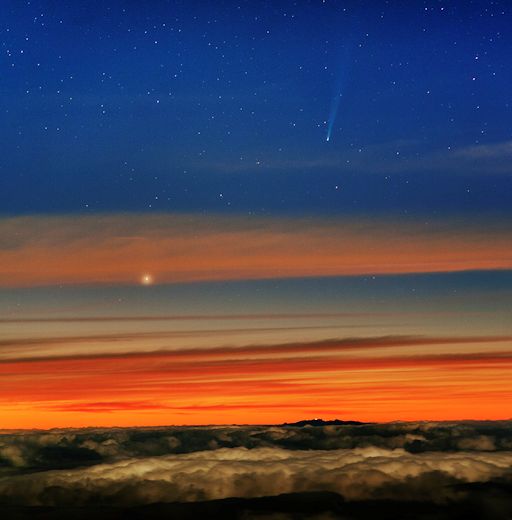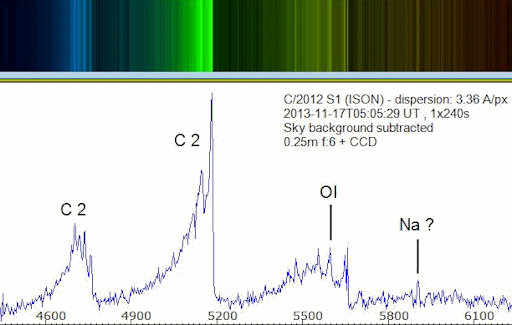When is the best time to see auroras? Where is the best place to go? And how do you photograph them? These questions and more are answered in a new book, Northern Lights - a Guide, by Pal Brekke & Fredrik Broms. | | | EARTH DODGES SOLAR FLARES: Solar activity is moderately high this week, but the eruptions (including an X-flare on Nov. 19th) have had little effect on our planet. The flare sites are concentrated near the sun's SW limb where a cluster of active sunspots is rotating off the Earthside of the sun. NOAA forecasters estimate a waning 20% chance of M-class flares and a 1% chance of X-flares as the active regions depart. Solar flare alerts: text, voice ISON, THE DAWN COMET: Comet ISON is plunging toward the sun and brightening as it heads for a perilous close encounter on Nov. 28th. This morning, with the "final countdown" clock at T-7 days, Juan Carlos Casado photographed the sundiver over the Teide Observatory in the Canary Islands: 
"The comet is over the distant island of Gran Canaria," he says, "while in the central cloud we can see the planet Mercury. ISON was at the limit of naked-eye visibility, but it was an easy target for my SLR camera with a small telephoto lens (85 mm focal length) on a static tripod and 6 seconds of exposure." Because Comet ISON is moving into the rosy glow of dawn, it will soon be impossible for cameras on Earth to track it. NASA's fleet of solar spacecraft are about to take over. Later today, Comet ISON will enter the field of view of the STEREO-A spacecraft. The Heliospheric Imager on STEREO-A will pick up the comet just as Earth-bound telescopes begin to lose it. In the days that follow, STEREO-B, SOHO and the Solar Dynamics Observatory will join the hunt, providing continuous views of Comet ISON all the way to perihelion (closest approach to the sun) on Nov. 28th. Stay tuned! Realtime Comet ISON Photo Gallery
Ephemerides: Comet ISON, Comet Lovejoy, Comet Encke, Comet LINEAR X WHY IS COMET ISON GREEN? Taken by hundreds of people around the world, the pictures of Comet ISON we receive every day vary widely in quality, context and camera settings. However, they all seem to have one thing in common: the comet looks green. Why? To answer this question, Italian amateur atronomers Paolo Corelli and Dario Comino used a high-dispersion spectrometer to analyze light from the comet's atmosphere. Here are there results: 
The spectrum of Comet ISON is dominated by a green spectral line from diatomic carbon (C2). This substance is common in the atmospheres of comets, and it glows green when illuminated by sunlight in the near-vacuum of space. The spectrum also shows a weaker but still significant blue emission line from C2. Comet ISON's mixture of green and blue light gives it the aqua hue seen in many long-exposure photographs. Finally, the spectrum reveals a contribution from atomic oxygen. This element is familiar to readers of spaceweather.com as a source of green light in auroras. Realtime Space Weather Photo Gallery
Realtime Aurora Photo Gallery
Realtime Comet ISON Photo Gallery Every night, a network of NASA all-sky cameras scans the skies above the United States for meteoritic fireballs. Automated software maintained by NASA's Meteoroid Environment Office calculates their orbits, velocity, penetration depth in Earth's atmosphere and many other characteristics. Daily results are presented here on Spaceweather.com. On Nov. 21, 2013, the network reported 18 fireballs.
(11 sporadics, 5 Leonids, 2 Northern Taurids) 
In this diagram of the inner solar system, all of the fireball orbits intersect at a single point--Earth. The orbits are color-coded by velocity, from slow (red) to fast (blue). [Larger image] [movies] Potentially Hazardous Asteroids ( PHAs) are space rocks larger than approximately 100m that can come closer to Earth than 0.05 AU. None of the known PHAs is on a collision course with our planet, although astronomers are finding new ones all the time. On November 21, 2013 there were potentially hazardous asteroids. Notes: LD means "Lunar Distance." 1 LD = 384,401 km, the distance between Earth and the Moon. 1 LD also equals 0.00256 AU. MAG is the visual magnitude of the asteroid on the date of closest approach. | | The official U.S. government space weather bureau | | | The first place to look for information about sundogs, pillars, rainbows and related phenomena. | | | Researchers call it a "Hubble for the sun." SDO is the most advanced solar observatory ever. | | | 3D views of the sun from NASA's Solar and Terrestrial Relations Observatory | | | Realtime and archival images of the Sun from SOHO. | | | from the NOAA Space Environment Center | | | the underlying science of space weather | | 
